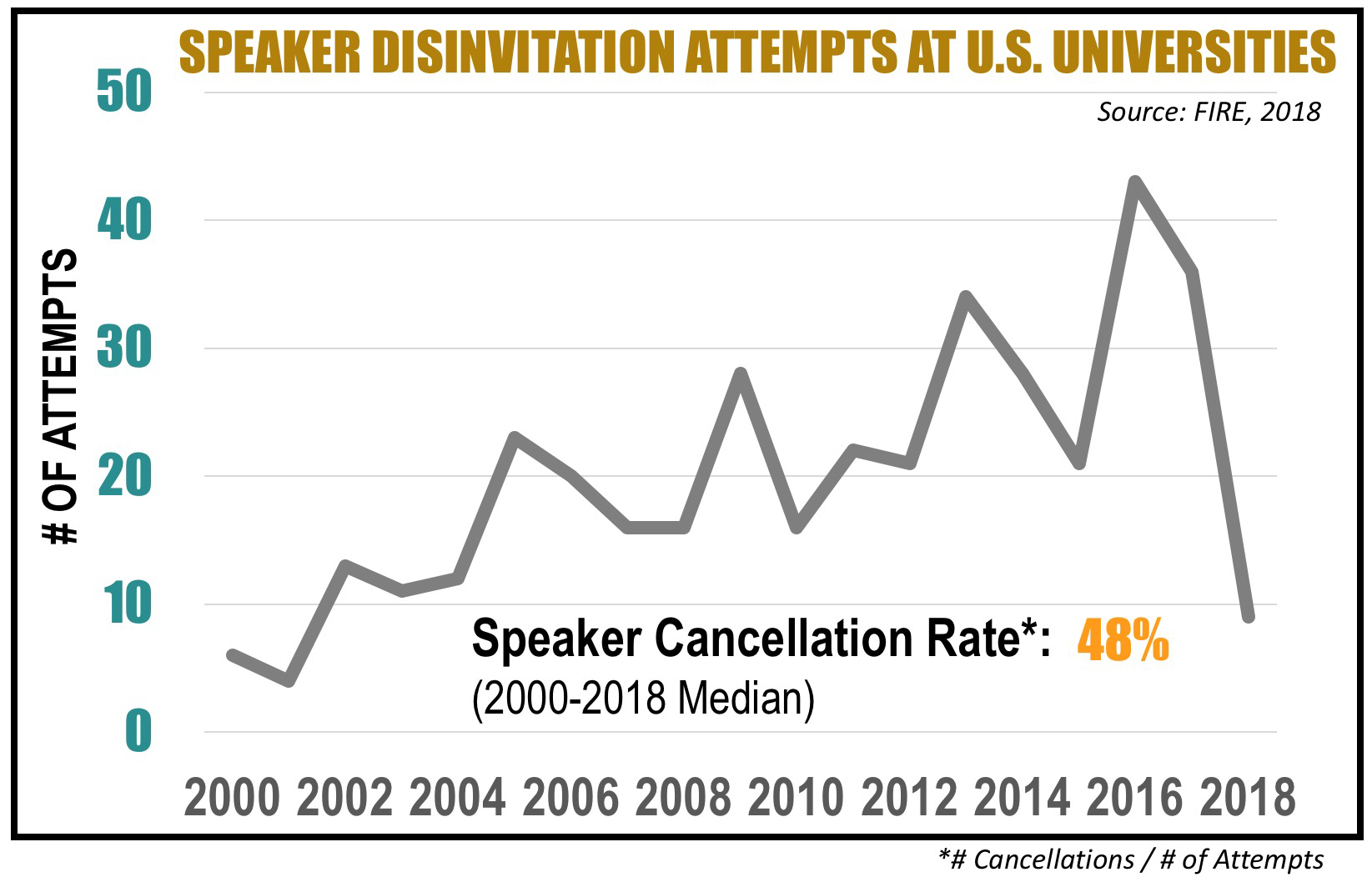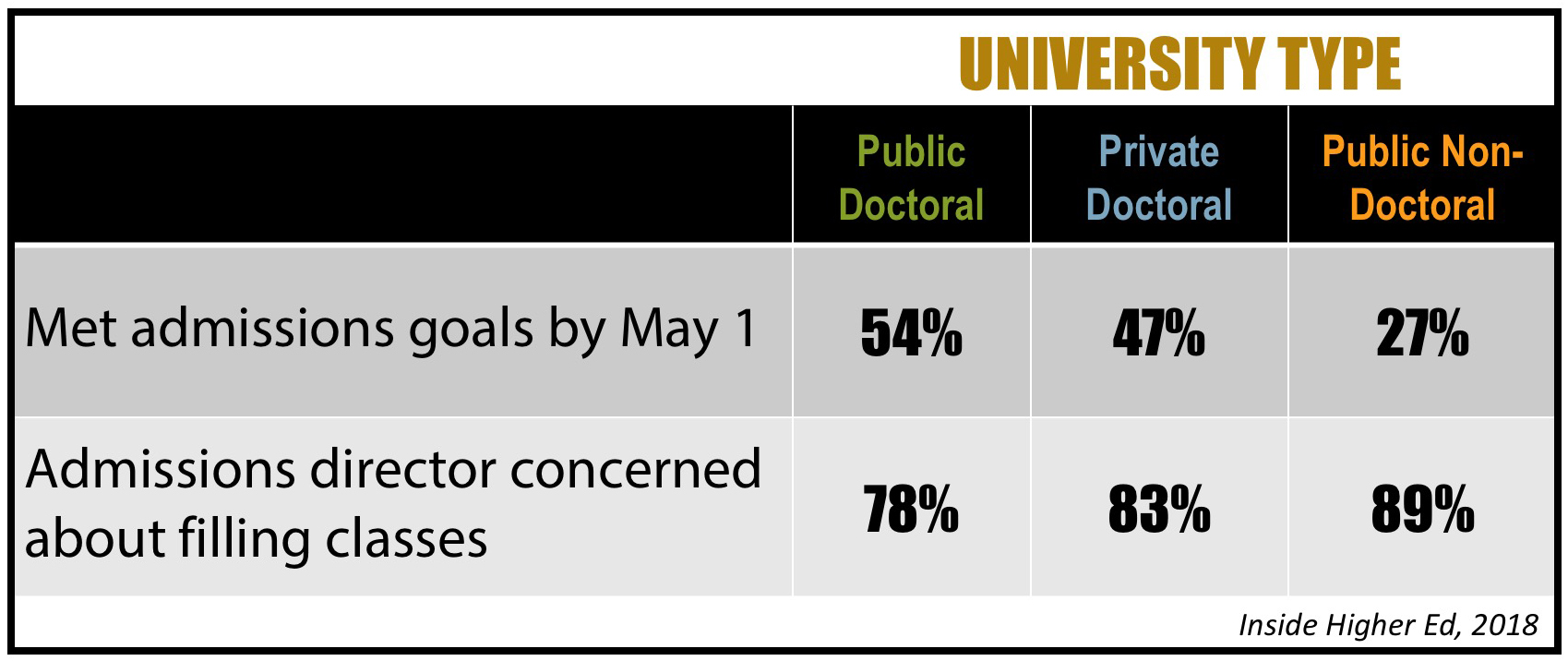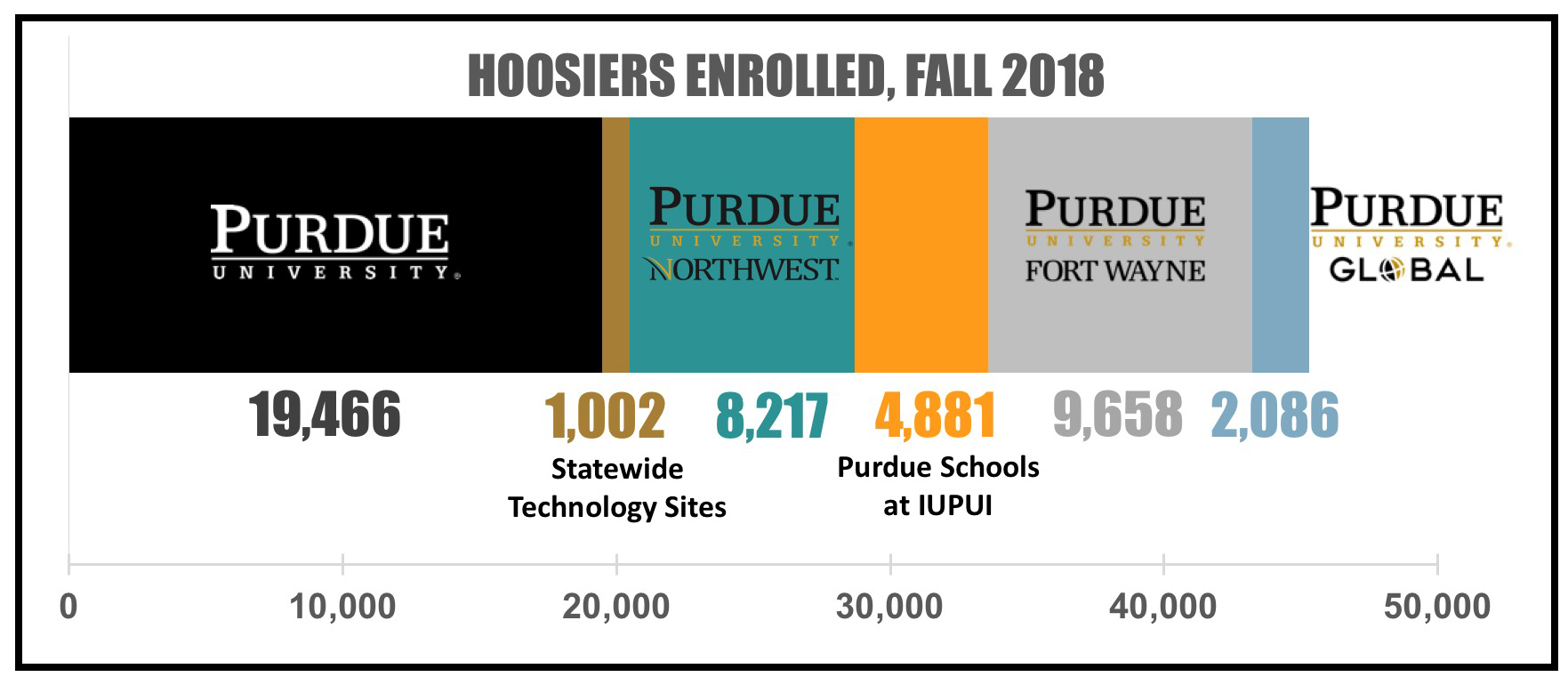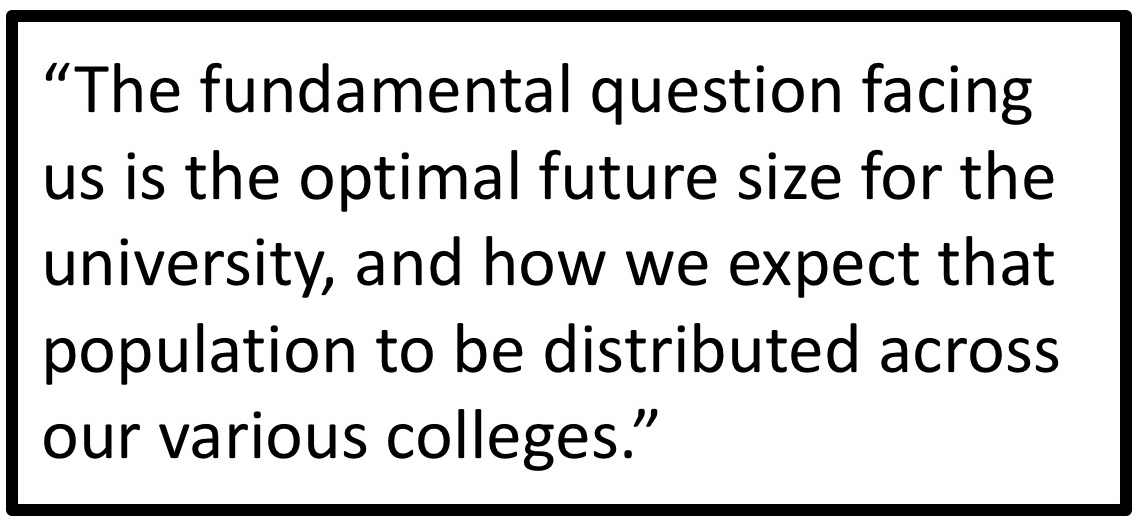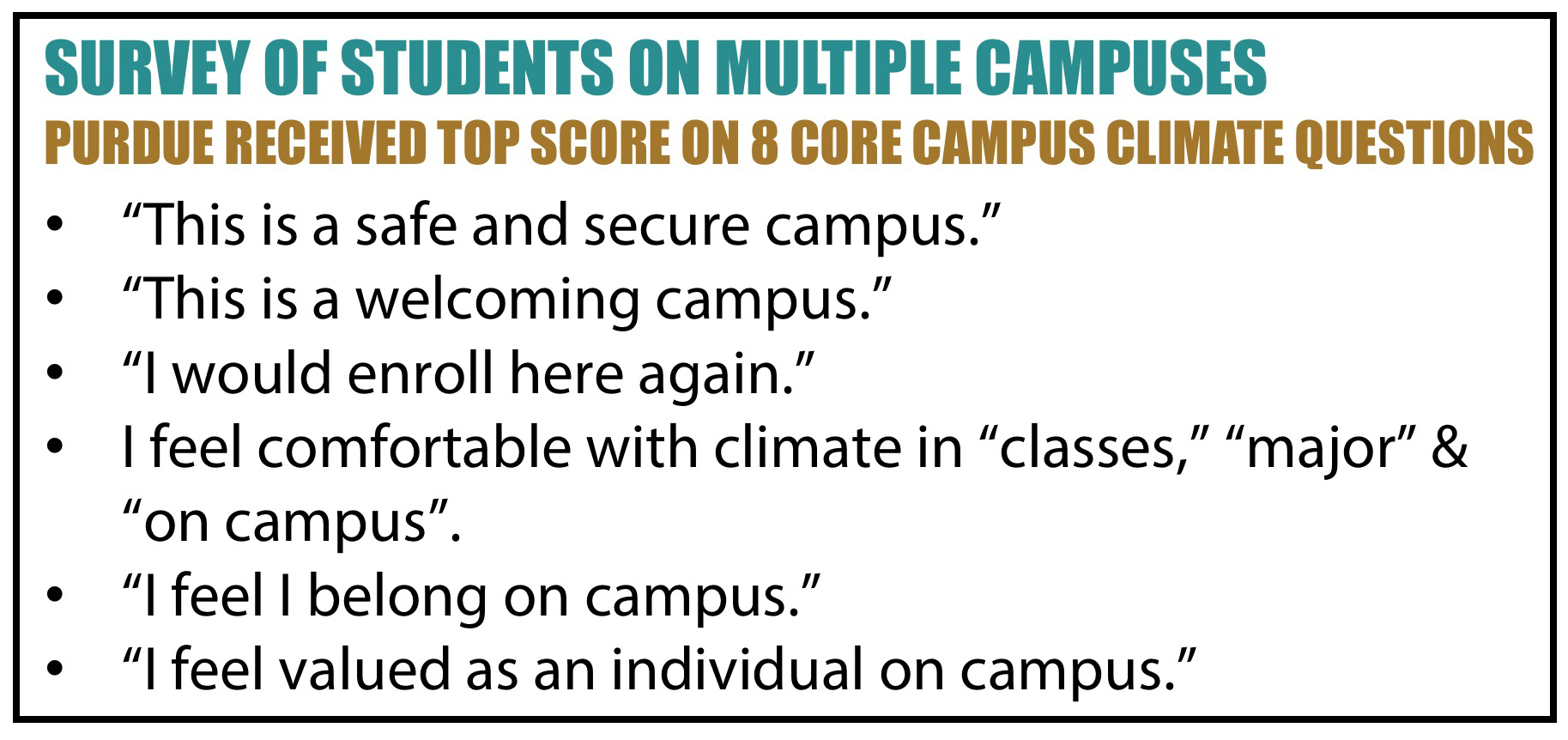Annual Open Letter to the People of Purdue from Mitch Daniels
January 2019
Last year I ventured the hope that one of these letters might start by reporting a “placid, relaxed year” in higher education. Well, 2018 was not yet that kind of year, but it’s fair to say that some of the turmoil and difficulty of recent times did abate a bit.
Tuition across the sector continued to increase, but at an apparently slower pace. I say “apparent” because, especially in the private colleges, the practice of back-door discounting, raising the stated “sticker price” while simultaneously offering bigger and bigger financial aid to favored students, clouds the picture. Reported “net tuition,” which attempts to account for the discounting, climbed 2.8% at private schools, and 1.5% at public institutions. Of course, these are relatively small percentage increases on top of what have become astronomical price levels in so many cases.
Abridgements of free speech and academic integrity diminished somewhat, too. Reported serious incidents of speaker harassment or disinvitations fell from 36 to 9 in 2018, with none reaching the disgraceful level of recent events at Williams, Yale, or Berkeley. At the same time, it’s impossible to know how much of the amelioration is the result of hosts avoiding potentially challenging speakers in the first place. Encouragingly, the number of schools adopting what we refer to as the Chicago Principles, as Purdue did three years ago, rose to 54.
But any honest report on the sector must be on balance highly cautionary. The multiyear decline in enrollments continued, with total student population falling another 1.7%. The flattening pool of 18-year-olds is the primary driver, but it was joined in 2018 by a new factor, the slippage of international student applications.
Between 2017 and ’18, the number of new foreign students coming to study in the U.S., after many years of strong increases, dropped by 6.6%, following a 3.3% decline in the previous year. A growing list of colleges have been aggressively marketing to young people abroad as an offset to their eroding enrollments. In late 2018, our neighbors at the University of Illinois announced that they had taken out an insurance policy, at a premium cost of $424,000, against a loss of international students in future entering classes.
Some have suggested that a more restrictive posture toward immigration by the current national administration is a cause of this reversal, and that may well be a part of the change. But competition is ramping up elsewhere, in places like Australia and the Netherlands, not to mention the inception of new and expanded institutions in China and other sending countries. And all of these alternatives are substantially less expensive than coming to the U.S.
At Purdue, we had anticipated a possible diminution of the flow of international students, and it was one reason for a rebalancing of our enrollment goals which I will discuss later in this letter.
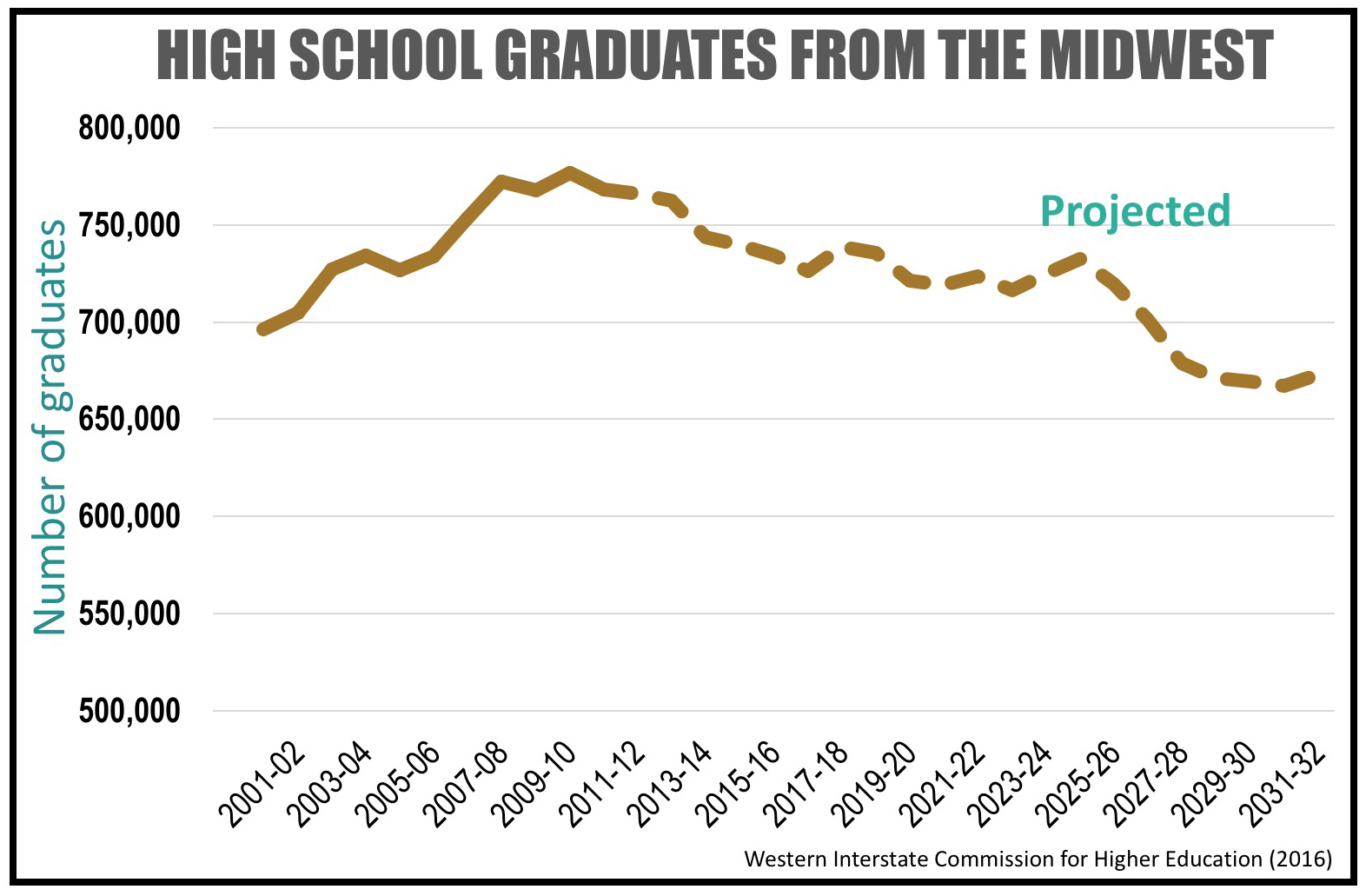
Meanwhile, financial distress continues to broaden. A quarter of non-public institutions reported running at an operating deficit in 2017-18. Finding one in five small private colleges under “fundamental stress,” Moody’s bond rating service renewed its “negative outlook” on the higher education sector, amid forecasts that the number of schools closing their doors would grow from 11 to around 15 per year. That may be the good news. For years, demographers have noted the coming decline in the total number of 18-year-olds. To this challenge, some have added the observation that a rising percentage of future cohorts come from backgrounds historically much less likely to attend college.
Of significant relevance to Purdue and the scores of schools concentrated in the Midwest and Northeast, more and more of tomorrow’s high school graduates are living in the West and the Sunbelt, not where most of our students have traditionally come from.
Finally, already sagging U.S. birth rates fell sharply further, starting around the time of the 2008 recession, and have not shown any signs of recovery. This “birth dearth” will begin to show up — one should say, not show up — in even smaller enrollments starting in the middle of the next decade.
A much-discussed book during the past year examined all these and other factors and predicts 10% fewer college-going students by 2029. It notes that past sources of additional students, such as older students and women, have long since contributed what they can. Nationally, women students now greatly outnumber men, by 57-43%, and more than a quarter of all undergraduates are older than 25.
Worried yet? There’s more. As these letters have mentioned before, more and more employers no longer require bachelor’s degrees in their hiring policies. Google, Apple, Ernst & Young, IBM, and Penguin Random House are among them. Apprenticeship and job-specific skills training are attracting increasing attention and favor as alternatives to traditional college diplomas.
Given the questionable curricular rigor at too many colleges today, there is no reason to expect that trend to do anything but grow. It should surprise no one that emerging data is beginning to challenge the standard higher ed retort that “college graduates earn so much more”; that was very true yesterday and across the workforce today, but may not be predictive of the future in which today’s high school Americans will live. One recent study found that more than 20% of recent graduates are “underemployed,” meaning working in jobs not requiring a college diploma, 10 full years after graduating.
In many places, that tough tomorrow is now. This past fall, barely half of all four-year schools reported meeting their admissions goals. The higher ed press has been crowded with accounts of measures that can only be described as desperate. In what one scholar called a “panic reaction,” institutions have added a stunning 41,000-plus new majors and programs in the last six years. That amounts to a 21% increase in offerings for a shrinking number of students. Of course, this runs parallel to the cutting of entire programs at schools struggling to stay alive financially.
The “amenities arms race” is still on. Over the last decade, luxury residence halls, climbing walls, and lazy rivers captured the most attention. Lately, the competition has moved on to — I’m not making this up — “concierge” services. Students can make dinner reservations, arrange tickets for upcoming events, or get their cleaning and laundry done. At a school that pioneered (if that’s the word) this concept, an official describes it as “a mother away from home” that does “anything a mother would do.” Lest you think this development is limited strictly to pricey private schools, at least one major public, New Mexico State, now touts its own concierge program.
I’m belaboring these environmental hazards because they bear so directly on decisions Purdue must make soon about our own future.
In 2013, after a few months of review with our trustees and faculty, we announced a set of steps that came to be called The Purdue Moves. Together, these 10 steps comprised a strategic direction which we have now implemented in all essential dimensions. Here is a quick look back.
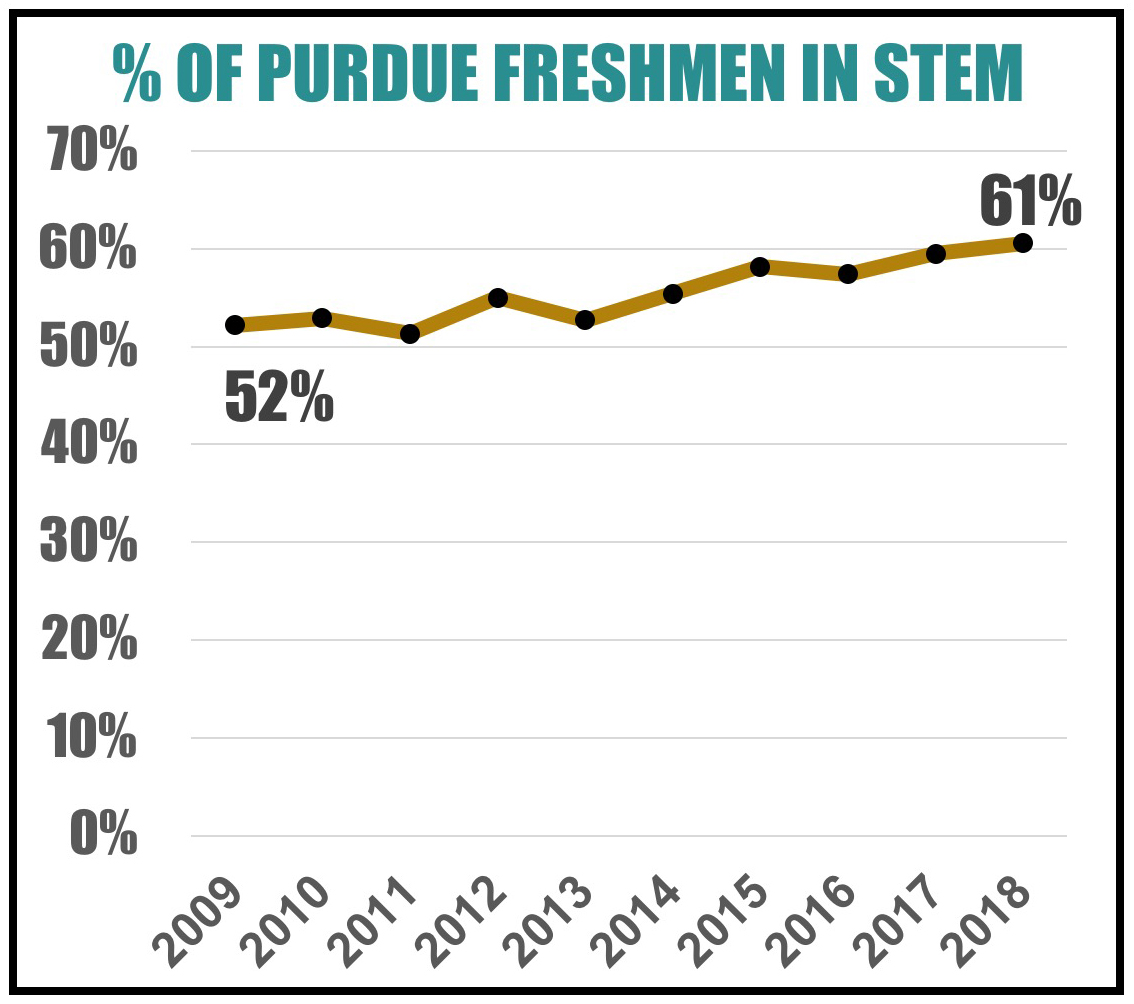
Determined to contribute even more to the need for graduates expert in the “STEM” disciplines, we expanded our Engineering and Computer Science enrollments by 2,500 and 1,000, respectively. Our former College of Technology completely reinvented itself, emerging with a new, project-based and increasingly competency-based pedagogy that has attracted national attention and more than a thousand additional students. The transformation was so comprehensive that it called for a new name, the Purdue Polytechnic Institute.
When the Moves began, Purdue was already one of the nation’s most STEM-centric schools. Taken together, these three investment programs took us further in that direction; for the first time, more than 60% of this year’s entering class chose a STEM course of study. Becoming even more concentrated in any one area involved some degree of risk, and we did not undertake it lightly, but looking back we believe that the choice has been validated by its outcomes.
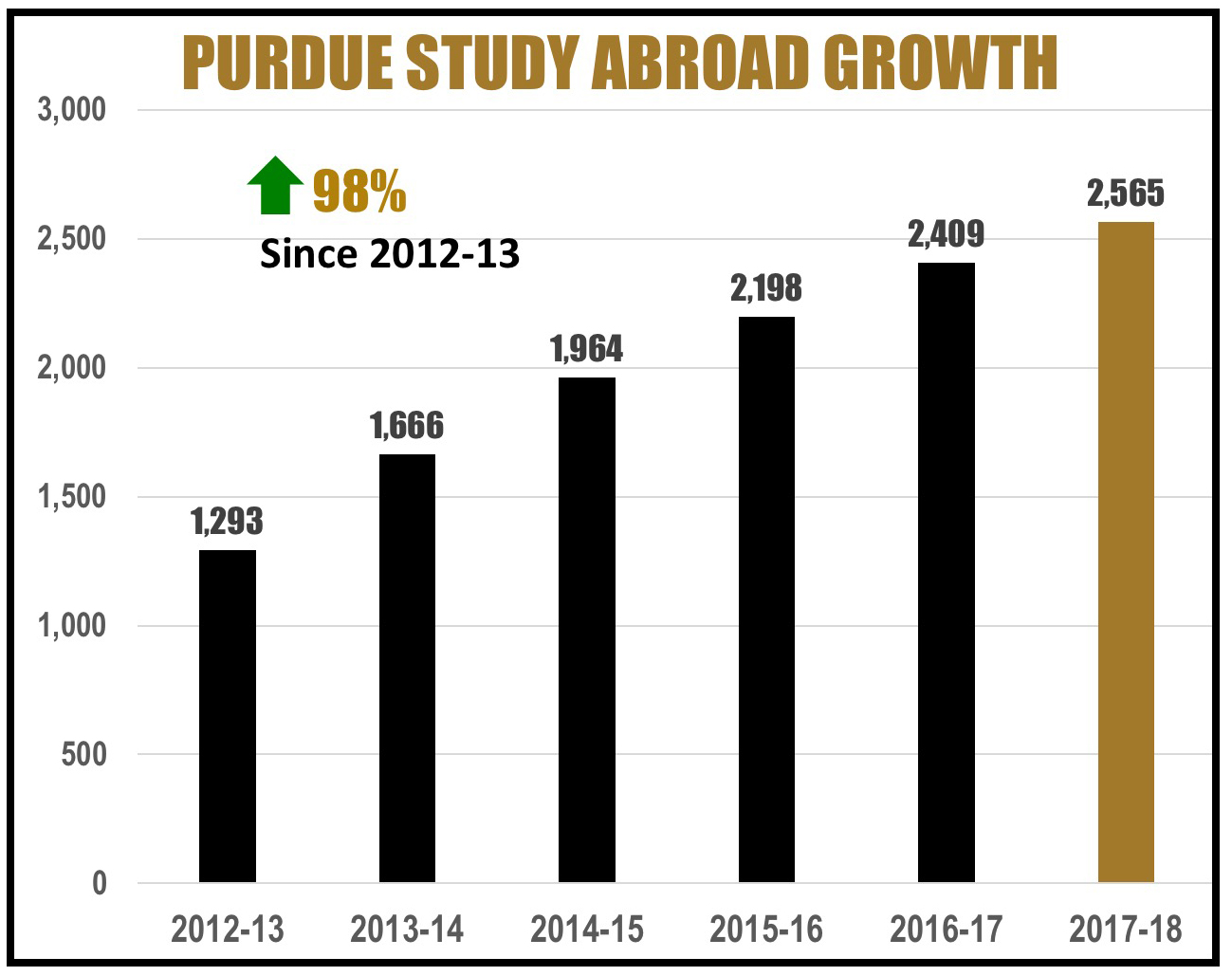
From among so many areas of research excellence, we chose three for major investment. Today, our plant science and drug discovery programs are world leaders, and our life science institutes in cancer, neuroscience, and infectious/inflammatory/immunological diseases are achieving their own renown, and along with our research portfolio generally setting grant and revenue records each succeeding year.
Our student-focused initiatives have fared well, too. We have more than doubled the number of Boilermakers studying abroad during their Purdue careers, and have come from nowhere to rank for the first time in the top 20 nationally in this category. Our efforts to encourage on-campus living (which is provably helpful to academic performance) have succeeded so well that, coupled with growing enrollments, they have produced temporary housing shortages at the beginning of the last two school years. And, at least measured by numbers of courses and students participating in them, we are now a national leader in the realm of so-called “active learning,” a spectrum of alternatives to the traditional lecture and recitation method.
During these years we broadened our commitment to our land-grant mission. With the consolidation of two units into Purdue Northwest, the realignment that produced a new Purdue Fort Wayne, and the successful establishment of Purdue Global to meet the needs of the working adult learner, we are now serving an unprecedented 45,000 Hoosiers. Included in this number are several hundred Purdue employees, who are now pursuing degrees online through Purdue Global, at no charge.
I believe we can view these decisions and their results with some satisfaction. In any event, as they come to fruition, we have arrived at a juncture when new strategic choices are called for. They can be made in part based on Purdue’s current momentum in size and reputation, but also in light of the sobering realities detailed above.
The wisest words I ever heard on the subject of “strategy” are that a real one is defined not by what it includes but by what it leaves out. In business, public life, and academia, we have all seen grand “strategies” that, because they felt compelled to respond to every pressure and include everyone’s pet project, ultimately were of no actionable value and expired, forgotten and unlamented, on a shelf somewhere. We must strive to avoid that all too human pitfall.
How Big?
The fundamental question facing us is the optimal future size for the university, and how we expect that population to be distributed across our various colleges. Purdue in 2018 is the largest it has ever been, in both undergraduate and graduate populations. Today’s freshman class, which set a record for total applications at over 53,000, at 8,357 students, is our biggest to date. The heightened interest in STEM majors has more than matched our 2013 projections.
But, more significantly, the Class of ’22 is far larger than we expected it to be. In other words, a much higher than anticipated percentage of those admitted chose Purdue over other schools. Given our primary mission to prepare as many young people as possible for successful lives and careers, in an era when so many of our sister institutions are struggling just to maintain themselves, these trends present the happiest of problems.
But are they a basis for forward planning? Can we responsibly and confidently grow any further? Is today’s size a new plateau on which we should plan to remain? In view of the coming demographic decline, is it possible we have overshot? If we do try to grow further, in what disciplines? And what are the myriad implications, for faculty size, capital plant, housing, food service, etc., of each trajectory?
We have made one adjustment over the last three years, involving our international undergraduate student population. Unlike so many schools, foreign students have long been prominent at Purdue, and a source of pride and distinction. They have enriched the Boilermaker learning experience for their domestic classmates, and done our university great credit in later life.
But during the early years of this decade, our international population swelled to, at its peak, 20% of one freshman class, and 18% of the overall student body. Moreover, a large majority of those students came from just three countries. It seemed time for some modest rebalancing.
We have managed down our total international population to 14% today, and less than 10% of the last freshman class, with a much wider variety of nations represented. Needless to say, we have had no difficulty attracting outstanding Hoosiers and residents of the other 49 states to fill the slots this has opened up. Purdue still is unusually diverse geographically, with the fourth-most non-American students among U.S. institutions, but we believe the overall balance is better. And we are less exposed if the recent slump in international applications continues.
With the Board of Trustees, we are carefully examining all options, aiming at making this most strategic of calls sometime this year. We will do so with a strong sense of mission, to spread the benefits of a Purdue education as widely as possible, but always tempered and informed by our duty of stewardship, to make certain the university remains strong and solvent in perpetuity.
The Master Plan
As unveiled around the campus in October, and featured in my monthly bulletin to alumni the next month, our Trustees have endorsed a new Master Plan for the university’s long-term physical development. To reiterate the essential point, this document is not a construction plan, but merely a conceptual one, laying out overarching goals and principles for tomorrow’s Purdue. Although a few of its elements are already in the works, most will be made real only if and when events support such decisions, and some will probably never occur.
Here again are the plan’s five objectives: 1) Invest in teaching, research, and collaborative spaces. 2) Prioritize major renovations. 3) Carefully focus housing and dining investments. 4) Enhance open space connectivity and campus circulation. 5) Strengthen campus identity and gateways. I would draw your closest attention to numbers 4 and 5, which will mark the biggest visible departures from the Purdue of today; you can see illustrative renderings and video on the Master Plan here.
"Throughput"
Pardon me for not yet thinking of a more elegant term, but regardless what total student number we aim at, an important goal must be to speed the pace at which Boilers move through school and complete their degrees. I have always found it uncomfortable that higher ed tabulates six-year graduation rates, as though that was a satisfactory result. The longer one spends in college, the fewer years one has to earn a living and contribute to society. And, of course, the more it costs to finish, which is why too many schools have been complacent, or even complicit, in policies or practices that made on-time completion hard to achieve.
As mentioned in last year’s letter, our College of Liberal Arts has led the way in fashioning three-year degree options for virtually every degree it offers. During 2018, it was joined by several other colleges in innovating new choices for especially enterprising students. These typically involve a clear map including one or two semesters with an extra course, plus some summertime credits, often earned online.
The College of Education has a three-year special education program in place, and curriculum and instruction programs in development. Health and Human Sciences now provides a host of majors, ranging from retail management to kinesiology to public health to hospitality and tourism management, on three-year tracks. All seven departments in the College of Science now offer three-year degree programs, including popular programs such as actuarial science and data science.
Meanwhile, other units are helping to build even more value into our four-year studies. Krannert is partnering with our three-year offerings to add a one-year Master of Science, while Engineering has devised “Do More in Four” through which students can add an MS, or a skill-specific certificate, or the Cornerstone package of liberal arts courses to the prized badge of a Purdue engineering diploma.
The Polytechnic Institute, in addition to setting up three-year programs in technology leadership and innovation, and possibly computer and information technology, is enlisting hundreds from each of its incoming classes into Cornerstone, furnishing them a quality liberal arts grounding to balance their STEM experience. This is a combination employers are increasingly telling us they seek and value in new hires.
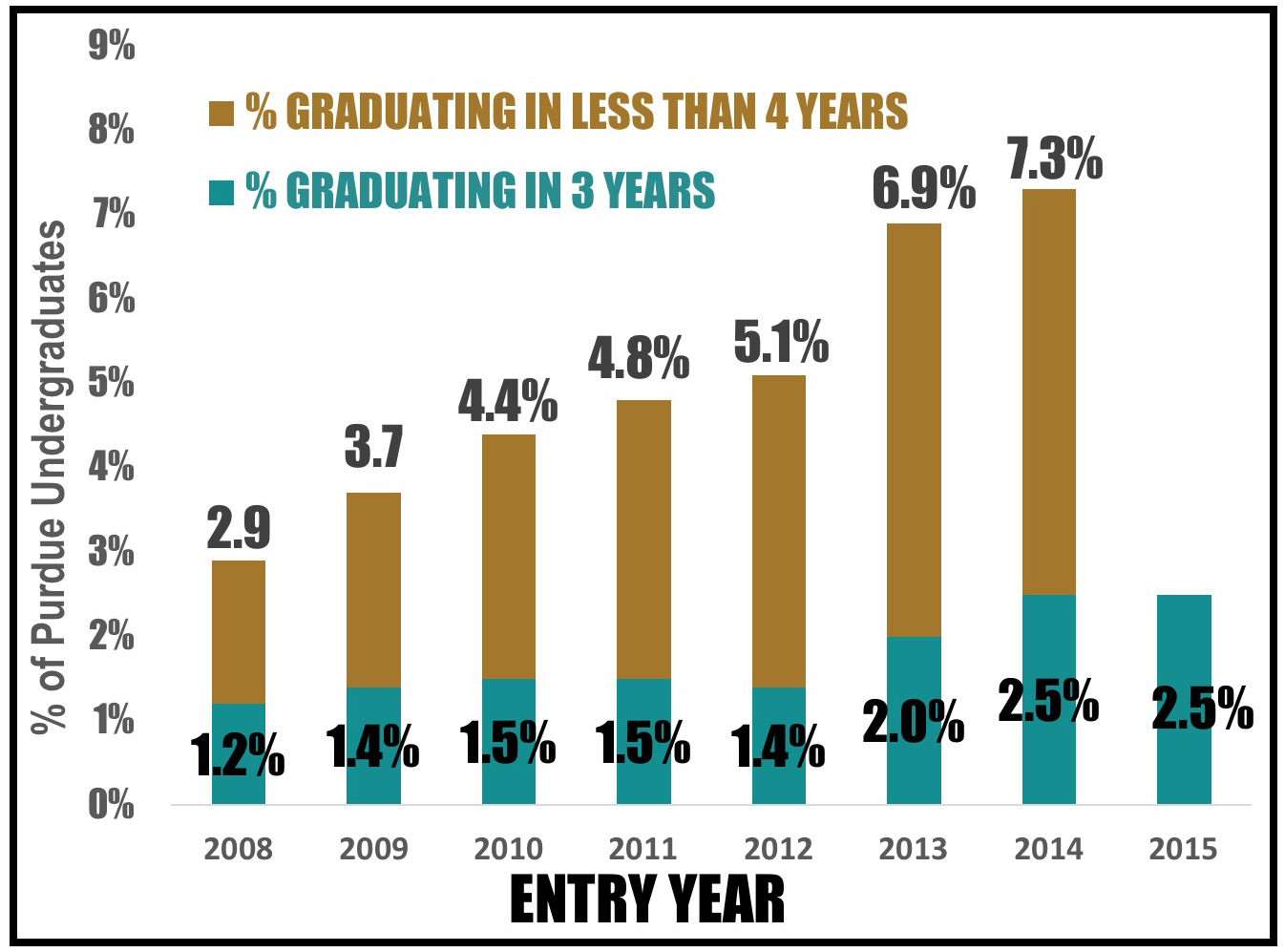
Between these new options, our work to encourage more summer study, and the matriculation of more and more talented freshmen, many of whom arrive with AP or dual credits earned in high school, time to degree is headed in the right direction at Purdue. We have always tracked four-year and six-year graduation rates; now it is making sense to follow less-than-four-year rates. Climbing at about a percentage point a year, they topped 7% in the 2017-18 graduation year and we are out to move them steadily higher.
Accelerating average time through school is mainly about helping students so inclined to save money and get an earlier start on life. But, if widespread enough, it would also protect Purdue against the threats gathering on the higher ed horizon. Like an efficient process designed by one of our Industrial Engineering graduates, faster “throughput” would enable us to prepare more students with each dollar of capital investment.
Each time we cut a ribbon on a new structure, the same nagging thought comes to mind: “I sure hope no one is standing here in 20 years looking at a half-empty building and saying ‘What dummy thought this was a good idea?!'” Careful analysis of our enrollment strategy, judicious use of our Master Plan as the evolving facts warrant, and effective action to assist each Boilermaker to move at the quickest pace suitable for them, can all contribute to avoiding scenes like that.
Rigor
In the 2018 letter, I surfaced the issue of rigor, noting quantitative and qualitative evidence that it has long been a Purdue hallmark, and asking how we might preserve a challenging academic culture as a means of giving our graduates an edge on their peers who cruised through more lenient schools. I observed that this important, differentiating objective was not primarily addressable through policy changes or an edict from the Provost’s Office, but would have to be the result of a broad cultural commitment among the thousands of faculty who design our curricula and give out our grades.
The unwelcome news is, despite a good deal of analysis and discussion, we cannot claim much headway in action so far. Provost Akridge and his team are still at work, along with the University Senate, examining approaches to what is admittedly an elusive goal.
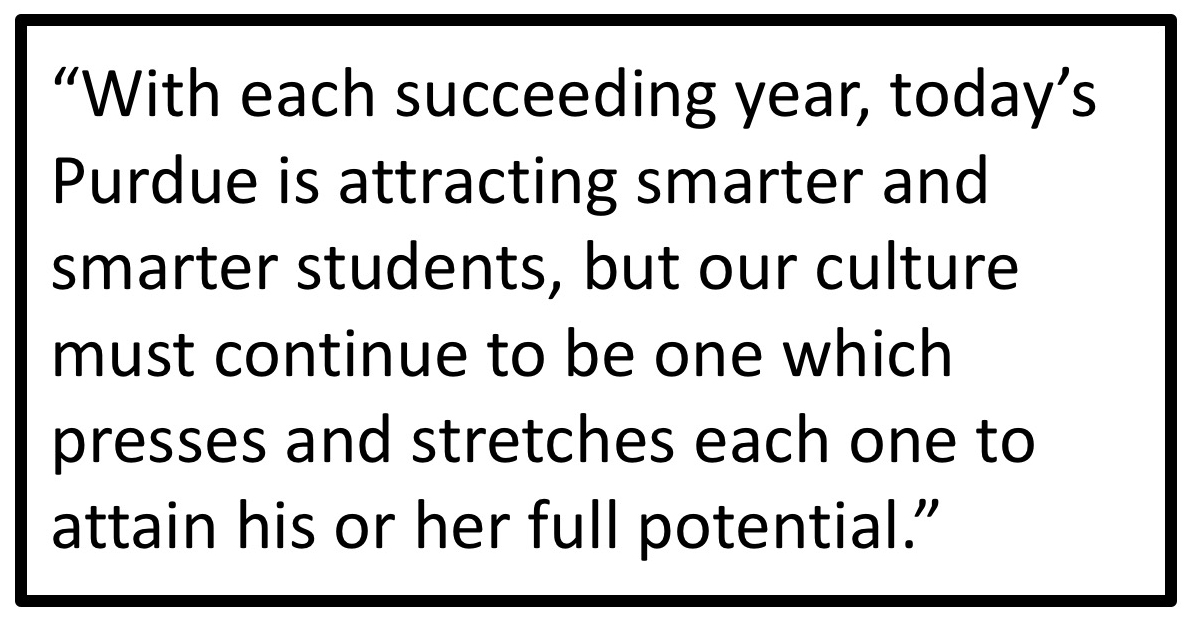
On the good news front, Purdue does still seem to hold its students to higher standards than many of our competitors. Among the other schools in the Wall Street Journal/Times Top 50 higher education ranking, it is now common for close to half or even more of all seniors to be awarded “honors,” generally given for GPAs of 3.5 or above. At Lehigh and the University of Southern California, it was 44%. At Johns Hopkins, the figure was 59%. At our 2018 commencement, Purdue awarded “distinction”, our term for honors, on just 10% of its diplomas.
Analyses confirm that, as the Journal put it, “(T)hat uptick is a sign of grade inflation, not smarter students.” With each succeeding year, today’s Purdue is attracting smarter and smarter students, but our culture must continue to be one which presses and stretches each one to attain his or her full potential. Which brings this letter to its last, and most complex topic.
Resilience
The vast majority of Purdue students show up ready to work and adjust well to all the changes that college entails. They move through the experience, including the unusual rigor of our coursework, with enthusiasm and good cheer, bouncing back from the occasional tough test, bad grade, or insensitive friend. College, and especially the transition to it, have always brought the risk of loneliness, homesickness, the fear of failure, and other natural concerns, but most current Boilers among the thousands I’ve met manage through these difficulties very well.
For many, in growing numbers, however, things prove harder. Their situations present an important challenge that our university, and all our contemporaries, must learn to meet effectively. For our provost and his colleagues, this is one of 2019’s top assignments.
A much-discussed phenomenon of our time is the stunning escalation in young people assessed, or assessing themselves, as needing psychological support or therapy. Pictures of even very small children lining up to be medicated at their elementary school are no longer shocking. Many of them and others will have spent time with psychiatrists or counselors of one kind or another by the time they finish high school.
Scholars are debating the causes of this eruption of emotional distress. Clearly, some highly positive developments like the destigmatization of mental illness are involved. New causes of anxiety, like social media, may well be playing a part. One much-discussed book, by Dr. Jean Twenge of San Diego State University, in its title declares today’s “super-connected kids … completely unprepared for adulthood” and assigns most of the effect to overuse of the new technologies.
Much other recent literature examines the role of overly protective parenting that prevents youngsters from learning to handle problems themselves, or leads them to conclude that the first response to adversity is to find an adult to address it for them.[i]
Whatever the sources, the problem is real and growing. A study published last year in Psychiatric Services claimed to find that one in three students on the 196 campuses surveyed met criteria for “a clinically significant mental health problem.” 27% of those screened were found to have depression. Even factoring for the natural self-interest of a psychiatric profession in discovering more business for itself (the Diagnostic and Statistical Manual, the profession’s compendium of discretely defined mental disorders, has grown from 145 pages in 1952 to 947 pages today), a very real surge is occurring.
At Purdue, in a pattern apparently typical across higher ed, requests for service have skyrocketed. Between 2013-14 and 2017-18, while the total (undergraduate plus graduate) population grew by 7%, appointments at our Counseling and Psychological Services (CAPS) office went up more than 100%. We have added counselors at virtually the same rate and expect to add more. We must do all possible to identify and assist particularly those with severe emotional problems.
Besides our mental health professionals, we have hundreds of other frontline staff in position to help. Our academic advisors and our upper-class student resident assistants already receive training in how to spot troubled students. We will put even greater emphasis on this task, augmenting it with better training in how to separate serious emotional problems from academic or social worries that perhaps we can learn to deal with on the spot, or in ways not requiring someone with formal psychological credentials.
Simultaneously we must continue nurturing an atmosphere in which, despite our scale, each individual can feel comfortable and at home. Here there is good news to report. 2018’s SERU (Student Experience in the Research University) survey of students on multiple campuses asked a number of questions going to the issue of “campus climate.” Typical questions ask respondents to agree or disagree with statements like “This is a welcoming campus,” “I feel comfortable with the campus climate,” “I feel valued as an individual on campus” and “I would enroll here again.”
Purdue respondents gave our campus the highest ranking across the peer group on a set of core climate measures, No. 1 on eight out of eight questions. That doesn’t mean we can relax our efforts to become even more welcoming and hospitable to students of all kinds, but it does say that we are a place where even a troubled young person can find support and a positive environment.
But beyond our existing efforts, we cannot shirk the duty to encourage in our students the resilience that a fully productive adult life will demand of them. Just as we seek to strengthen them in intellect, critical thinking, and character, we must endeavor to foster the confidence and self-reliance they will need when they leave campus.
This is a hard subject to talk about, let alone to address effectively. We must become constantly better at finding and helping those in genuine need. But I believe we default on our duty to prepare tomorrow’s leaders, in the Boilermaker tradition, if we fail to fortify the qualities of resilience and “grit” that often matter more to a person’s ultimate success than anything learned in class.
More Than Just a Birthday
Befitting Purdue’s status as one of the world’s premier centers of scientific advance and intellectual thought, we are commemorating our 150th anniversary with a yearlong Ideas Festival, extending from Homecoming 2018 to Homecoming 2019. The last three months saw a host of intriguing and illuminating programs, all designed to involve students, faculty, and interested alums. Guests on campus included such world-renowned figures as Steven Pinker, Bill Nye, and Nobel Prize winner Barry Barish. Our fifth annual Dawn or Doom conference attracted a record number of attendees. We hope you will watch for upcoming events, participate in the conversations through Purdue’s various social media channels, and bring your curiosity and your own ideas to bear on our Boilermaker birthday party.

This sesquicentennial year, as much as any since 2013, will also be a year of strategic decision making at your university. The selection of a trajectory for future student population, while no guarantee that we can continue achieving our targets, will drive other choices, around capital investments, tuition and fees, and other financial matters. In view of the realities catalogued at the beginning of this message, we will make those decisions soberly and thoughtfully, recognizing that Purdue’s recent successes provide no assurance about tomorrow.
But, without prejudging which direction the data will support, I confess that I will be approaching those decisions in a spirit of strong optimism. The headwinds of cost, demography, and declining public confidence buffeting higher ed offer more opportunity than danger to a school like ours. Whether in business, in the competition among the 50 states, or in the years ahead for our sector, tough times favor those providing the most value. Today, record applications, research grants, and donations tell us that is Purdue. We intend that to be even more true in the years ahead. Just don’t expect any concierge services.
Happy 150th New Year. Boiler up.
![]()
Mitchell E. Daniels, Jr.
President
[i] See for example, “The Coddling of the American Mind: How Good Intentions and Bad Ideas are Setting up a Generation for Failure” by Greg Lukianoff and Jonathan Haidt, Penguin Press, 2018.
